1970 Plymouth RTS Road Runner
By Cliff Gromer Photos by TheBruntBros
This is the story of the 1970 Plymouth Rapid Transit Caravan that Chrysler had built as a show car. At the time of this writing the car was owned by Steve Juliano who had found and owned 3 RTS cars. Steve is no longer with us, having departed to the Great Beyond. His RTS cars, along with his amazing collection of Chrysler memorabilia have been auctioned off piecemeal to various collectors. –Cliff Gromer
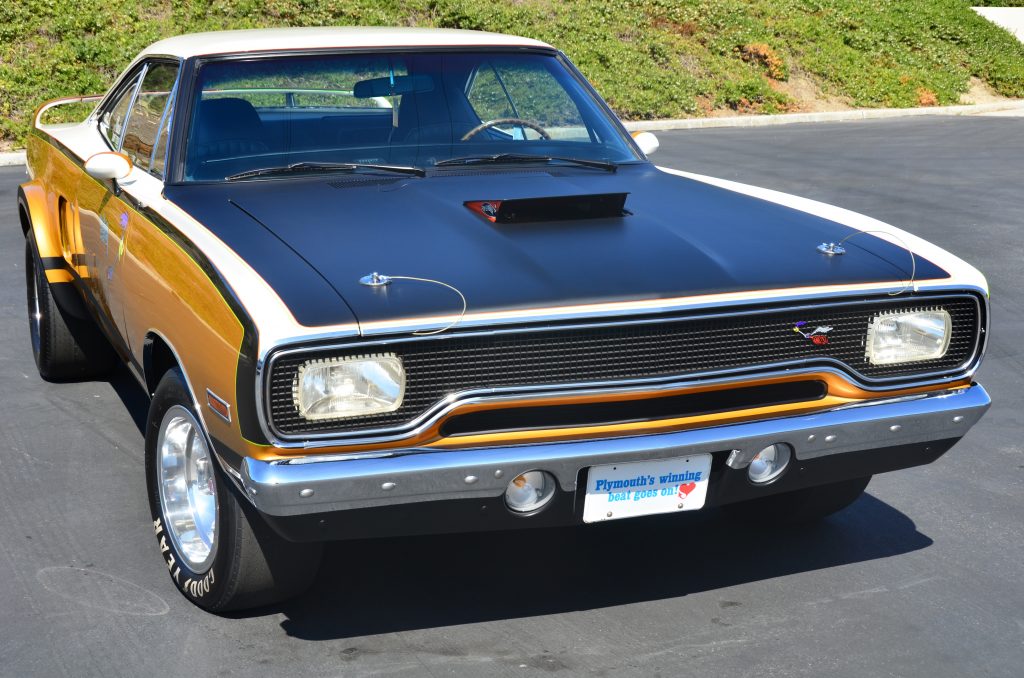
Behind the egg crate grille is an original â70 Road Runner grille. The egg crate material is ceiling tile that they cut and fitted. There were no headlight bezels. The opening below the grille and above the bumper is stock. Square headlights (Cibie) were unique back in â69 and early â70. All the windshield stainless has been matted out with Organosol.
Chryslerâs press release summed it up pretty well:
âPlymouthâs Rapid Transit System Caravan, a new mobile display of customized high-performance cars and parts, is on a coast-to-coast tour of the United States.
âFeatured in the Caravan are four Plymouth models whose bodies have been altered and decorated under the strict guidance of Chrysler Corporation by some of the nationâs top performance customizing shops. The Caravan is being exhibited at about 100 Chrysler-Plymouth dealerships as well as major racing events.
âThe customized cars in the Caravan are:
âA replica of drag racing champion Don Prudhommeâ funny car–1970 Plymouth Barracuda with a supercharged and injected Hemi engine that puts out more than 1500 horsepower.
âA Hemi Road Runner that advertises itself with over-sized Plymouth Road Runner birds painted into the body sides.
âA âCuda 440 which is the most extensively altered vehicle of the four vehicles exhibited in the Caravan.
âA Duster 340 which has been re-styled to include a rolled-under front pan and unique spoiler built into the rear of the roof line.
âAlso included in the mobile Caravan are two cutaway performance engines and a display board of performance parts. There also is a 27-minute movie on the history of drag racing which highlights Plymouthâs latest drag racing accomplishments.â
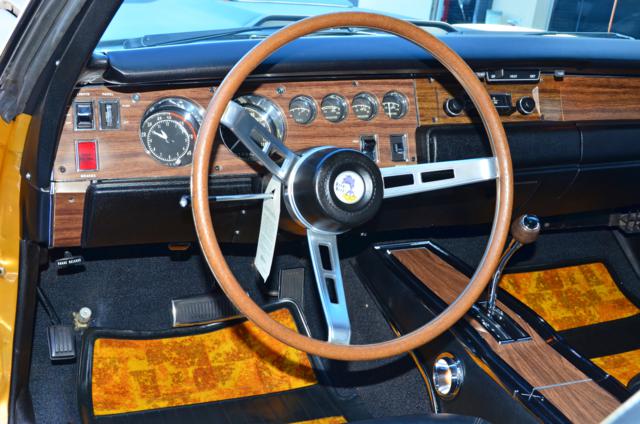
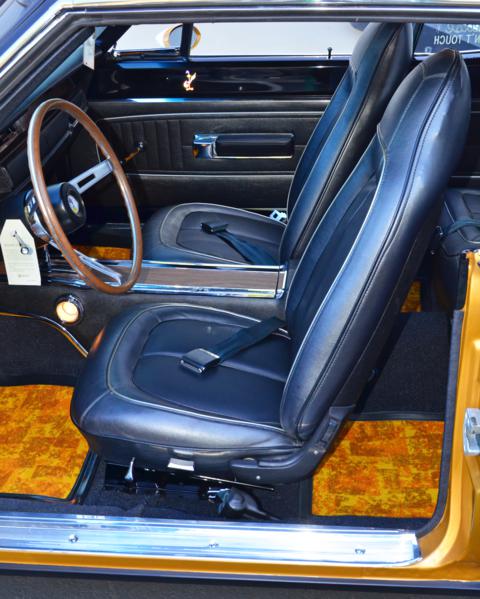
Road Runner shows only 1700 milesâarguably the lowest mileage Hemi Road Runner on the planet. Interior is 100% all-original.
Credit for the RTS Caravan goes to Bob Larivee Sr. , owner of the International Car Show Assoc. and 60+ years in putting on the Autorama. Bob explained to Chrysler, back in â69, that everybody was customizing cars and that it would be really cool for Chrysler to build a road show of their Rapid Transit cars, called the Rapid Transit Caravan hauled by a customized 18-wheeler. Larivee was behind the entire program that would be unique to Chrysler. Chevy didnât have anything like this, neither did Ford, although Ford guys say they had the Cobra Caravan, but that was just a bunch of dirty old race cars.
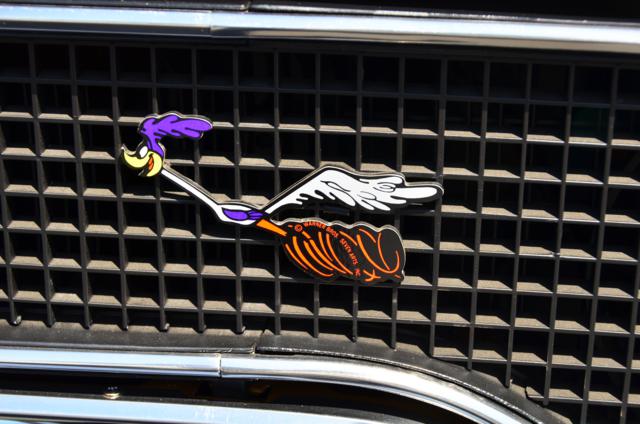
The custom-made Road Runner emblem in the grille is a â69-â70 Road Runner decal mounted onto a piece of plastic to look like an emblem. Itâs visible in the original press photos of the car, then, all of a sudden it disappearedâprobably ripped off as the car traveled around. Juliano made this one himselfâhe says he canât tell the difference.
To get the show rolling, Chrysler interviewed and hand-picked the best customizers of the day and the best designer of the time–Harry Bradley. Bradley, along with Chryslerâs designers designed a Duster, a âCuda, and a Road Runner which the customizers then built. One of the cars was the â70 Road Runner–featured here–that was built in Romanâs chariot shop in Cleveland, OH.
The debut of the RTS Caravan was the 1970 New York Auto Show at the NY Coliseum. But Roman did not have the âRunner ready in time. Chrysler called in Butch Brinza of Marquette, MI, who built the RTS Duster along with Byron Grenfell of Grenfellâs Customs, to customize, at the last minute, a GTX. There was a GTX in the Rapid Transit Caravan for that one show only. The GTX was just custom paint pretty much and a set of Cragars. By the second show, the Road Runner was ready and the GTX was pulled from the lineup. Whatever happened to that car, nobody knows.
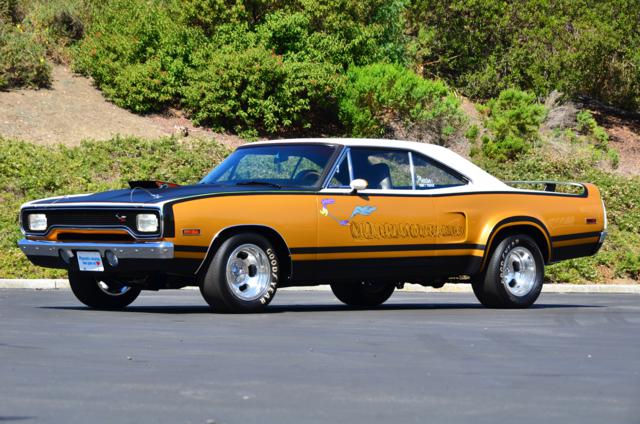
There are no door handles on the car. Some show cars had elaborate remote-control hidden buttons and hidden wires. This car has an elaborate quarter-glass–you open it reach in and open the door with the handle. The side-marker lights are â70 C-body. The bird decal is a â69 original, the extended dust trail is hand painted. The side scoops are elongated to be more dramatic. Tremendous rear wheel flares cover huge one-off Ansen wheels. Ansen was a sponsor of the Rapid Transit Caravan. Rubber is Goodyear Bluestreak Sports Car Specials.
For the â71 show season, the âCuda, and Duster were re-customized because there wasnât a body change on those models. But the Road Runner had to be built from scratch because the B-bodies changed dramatically from â70 to â71. The job was given to Chuck Miller because Roman had dragged his heels on the â70. Miller banged out whatâs commonly known as the âChicken-Head Car.â The RTS Caravan cars hit the circuit for two years and then Chrysler mothballed them.
The â70 beeper was given to a celebrity Detroit Lions football player. He thought it would be cool to make a race car out of it, and he delivered the Road Runner to a speed shop for the conversion. The speed shop bought a bunch of race parts for the car and waited for the football dude to pay for them. He never did. He had been cut from the team, and shortly thereafter went through a divorce. He never returned for the car.
Not having been paid, the speed shop never turned a wrench on the ‘Runner, which, in the long run, was a good thing. The shop eventually obtained a mechanic’s lien for the storage fees and sold it, in 1975 to a young mechanic employee, named Steve, who had aspirations of restoring it. Then, the car simply disappearedâinto Steveâs garageâfrom 1975 until 1995. At some point, Steve had Galen Govier decode the build sheet that he sent him along with photos of the car. The gumbers nuru offered the following adviceââIâve no idea what this car is, except it is a very early build car. I recommend you get rid of the funky paint along with the fender flares and square headlights and turn it back to stock.â Galen had no idea that he had inadvertently stumbled onto the highly sought after rare factory show car at the same time that Juliano was looking for it and plastering photos of the car all over the planet.
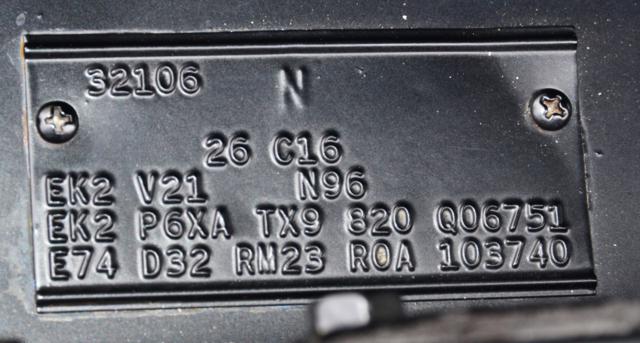
This is the 2nd Hemi Road Runner built and it came loaded with options.
In the early 1990s, Steve Juliano embarked on a mission to assemble the Rapid Transit System Caravan into one collection. “The cars just belong together,” he said. Having already acquired two of the Caravan customsâthe 1971 Road Runner and the â70 Duster. In Steveâs mind, the â70 Road Runner was the prettiest of all the RTS cars. It was a Hemi, and he had to have it.
 Steve ran ads for the car for years in Mopar mags and Auto Trader for years with absolutely no luck. Then, one day, he got a phone call from a guy and his words were âWhy are you looking for my friendâs Road Runner so hard?â This was pre caller ID. Steve told the caller the truth: that he had the other car and he wanted to reunite them yadda yadda. The caller said heâd have his friend call. That was it. The guy hung up and Steve just sat there staring at the phone like âWhat just happened, will they ever call again?â
An hour later, which seemed like an eternity, Steve received a call from the guyâs friend. A real deep voice on the line asked Steve to explain why he was looking for his car. And again Steve tells him the truth. The caller says âWell, if youâre ever in Battle Creek, MI you can come look at the car.â Steve replies, âItâs funny you mention that because Iâm going to be there on business.â Steve, of course, had no idea where Battle Creek, MI was. All he knew about the place was thatâs where you sent your Kellogâs cereal boxtops for prizes. Thatâs how Steve got his Woody Woodpecker bowl with the Tony the Tiger spoon.
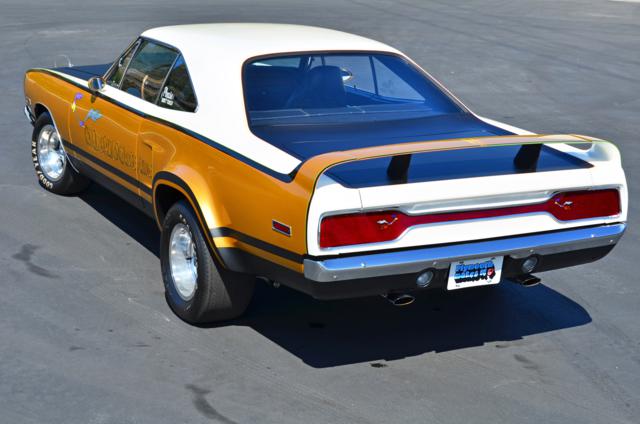
The taillamp assembly is a custom one-off, one-piece reflector. Bottom trim is standard Sport Satellite. Top trim is a bottom piece of trim flipped upside down. There are a lot of seams where it was cut to fit. The rear bumper, like the front has the bottom section blacked out to make it look narrowerâlike an E-body. Big chrome oval bolts fill the holes where the rubber strip was on the â70 Road Runner. The spoilerâs a one-off custom, beautifully done the way it comes off the quarter panels.
Steve makes the trip and meets the guy at a gas station in Battle Creek. Sizing up Steve as a good country boy and not a dago from New York, he takes Steve back to his house, pulls up the garage door, and⊠there it is! Heâs face to face with the car heâd been looking for all those years.
The Hemi drivetrain was sitting next to the car. The interior was perfect–just as you see it here–completely 100% untouched. The guy had decided to start sanding the car down. It sorta looked like a Delorean with all the bare metal showing. Steve remembers looking at the Road Runner, and the guy asked âIs that it?â Steve grumbled something, it was like a grunt, he couldnât speak. It was the car.
They negotiated a price and the deal was done. The car had so little of its paint remaining, it was impossible to get a baseline for a restoration as far as the correct custom colors. Steve mentioned that the wing was missing. The garage had a little loft that the guy disappeared into. He came back with the wing wrapped in a blanket. He asked âDoes this help?â That wing had the gold, the metallic brown, it showed the reversing of the pinstriping, the design of the pinstriping, the Organosol, the white pearl. Every color on the car was in that wing, it was just dumb luck that he never got around to sanding that. That wing, literally, was the Rosetta Stone for that Road Runner. The seller also handed Steve the Galen Govier-decoded build sheet on the car.
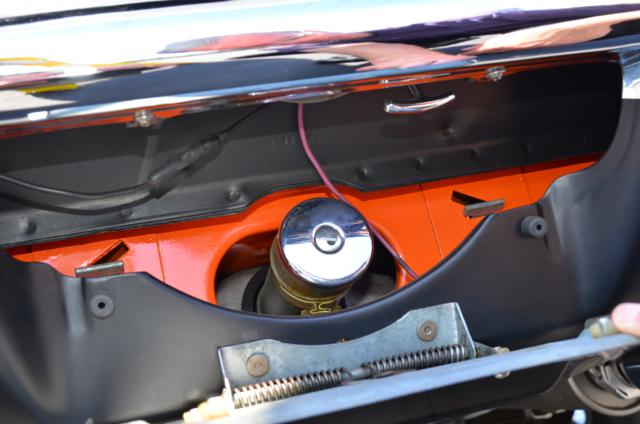
Originally an orange car, the builder painted and blacked-out only those areas that were visible. so the area behind the license plate was left orange. Trunk opens with the chrome pull-handleâidentical to what was used by Volvo for their choke lever.
Steve brought the car to his restorer, Ken Heckert in Glen Rock, PA. Ken did a phenomenal job recreating the custom paintâabsolutely nailing the colors. Steve says the Organosol is the best heâs ever seen. Ken used 20-30 year old Organosol, not the stuff thatâs available today and it laid beautifully. The real challenge was getting the big birds and the dust trail correct on the doors. Steve came through with the birds–the original â69 birds from Chrysler–the ones they sold to dealerships to decorate the â69 Road Runners Car of the Year on the showroom floor.
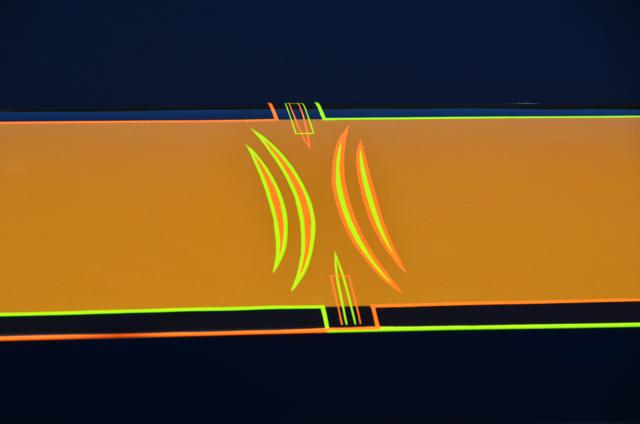
Original paint on the spoiler shows the reverse pinstriping.
The dust trail and the pinstripes were another story. Steve and Ken interviewed a few guys and, frankly, they were all young and they had all rolls of tape with them. Steve didnât want anybody near this car with a roll of tape and a razorblade Ken found this old-timer who came by in an old car. He looked at the project and said, âI could do it but I just donât want to. Iâm too old, itâs too much work, itâs not my thing.â Steve said, âHeâs perfect. This guyâs messed up, heâs perfect.â Ken sorta talked the guy into it, pretty much calling him a wimp. âYou canât do a job like this?â Then, when Steve told him he had to match the dust trail, that it was done by hand, the guy nearly had a heart attack because that dust trail is so elaborate. The guy came through 100%–an amazing job of recreating the dust trail from photos, down to the âWarner Bros. 7 Arts Inc.â logo underneath, and all the pin striping–freehand! Truly, a virtuoso with a brush, and master of a lost art.
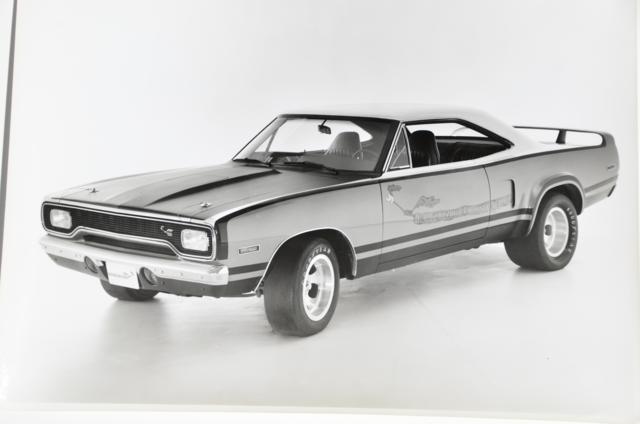
When Harry Bradley designed the car he left off the mirrors for a cleaner look. Corporate freaked out because you canât encourage people to remove their side mirrors. By the time the Road Runner made its show rounds it had mirrors that had been painted off the car duplicating all the custom colors and intricate striping. The mounting screws are not painted because the mirrors were an add-on.
The Road Runner itself is a standard Hemi automatic–the 2nd Hemi Road Runner built in â70. It was born an orange car and loaded with options. Steve said he knew when he restored the car there were places that, when Chrysler customized the car for the shows, they didnât shoot to cover up the orange. Remember, all people that customized cars or built concepts and prototypes, if theyâre starting out with a stock car or a stock body they want a black car. The RTS Duster came in white, the RTS â71 Road Runner came in orange and this car came in orange which means you now have to black out inside the trunk, black out everything under the hood, black out the wheel wells. Steve knew they wouldnât black out everything, so when he got the car, he looked for whatever orange was peeking through and had Ken reshoot that in orange–the panel in the back behind the bumper, the wheel wells and even the hood hinges. He also knew the hinges would scratch and he wanted them to scratch orange.
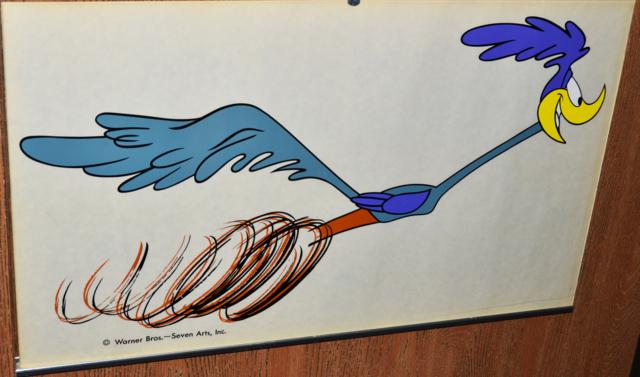
Oven-stuffer sized Road Runner decal (right-hand and left-hand for driverâs and passenger doors) could be ordered by any dealer. Juliano has original order forms and a few sets of the original decals as well.
Underneath is completely stock, parts-wise, hoses-wise, belts, cables , date-coded exhaust, date-coded shocks. This car was done in the year 2000, 12 years is a long time in the restoration world and a lot of new things have been learned.
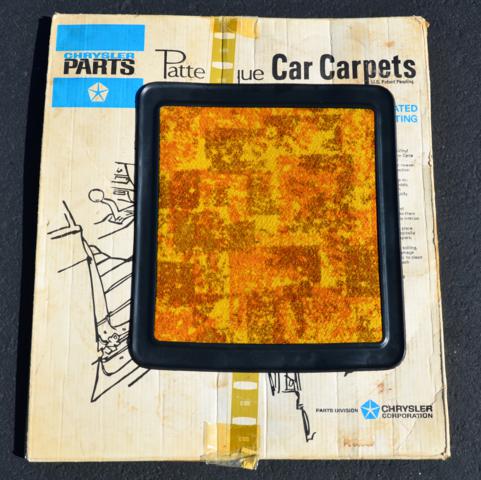
Those wild âPatterniqueâ floormats were available through Chrysler Parts. The came in red, gold/brown and green/blue.
âThereâs one lesson everybody has to learn about a car that was done 12 years ago vs. a car thatâs done today, and technique is a part of it. But itâs still the freakinâ parts. 12 years ago I found stuff on this car that youâre not going to find today if you stand on your head, such as NOS plug wires in the box, NOS positive and negative cable, date-coded mufflers, power steering belt, alternator belt, upper and lower radiator hoseâŠthis is stuff I had started collecting in the â90s. I knew it would come to this car,â explains Steve. A lot of the 1700-mile original stuff went south when the âRunner was in the shop to be converted into a race car.

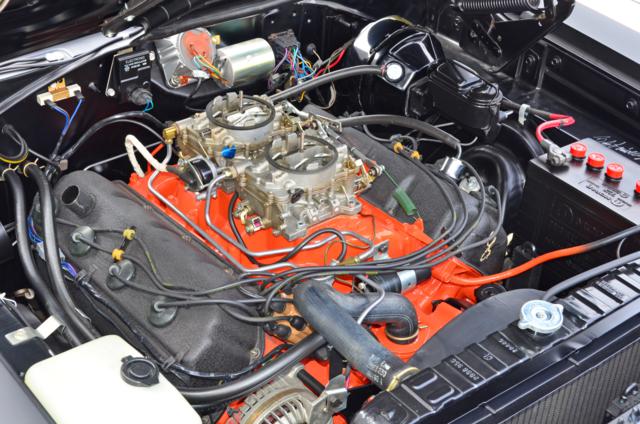
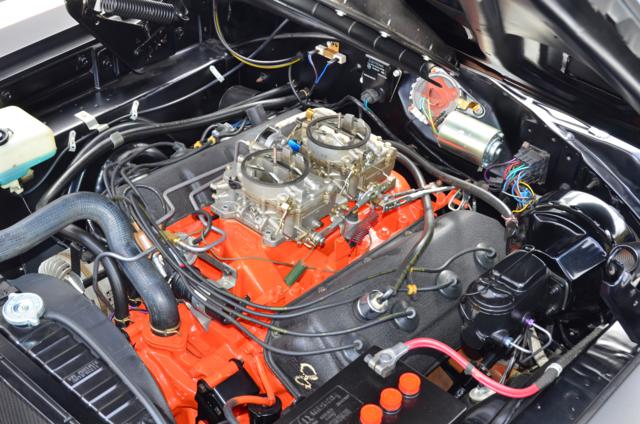
Rushed to meet a deadline, the early production â70 beeper came through with â69 valve covers. Reference-restored engine compartment wears the best of Julianoâs assembly line (lunch pail) parts that he began collecting in the 1990s.
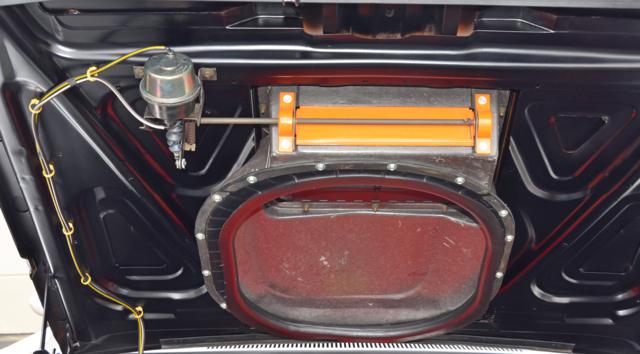
Air Grabber used a prop rod to keep the hood flap permanently raised.
The restored Road Runner joined the others in Julianoâs amazing collection of cars and extensive memorabilia. Steve wanted Bob Larivee to come out and autograph the three Rapid Transit cars with a silver Sharpie to sign on the blacked-out engine compartments. Steve brings Bob to his building housing the collection and makes Bob wait outside until he turns on the lights. itâs a big presentation for the father of these cars to be re-united with his children. Bob comes in and Steve hands him the pen, Bob looks around at the dozen cars in thereâ3 are Rapid Transit carsâreal radicals that are screaming at you, and the other 9 are bone stock. Bob looks around again and asks, âWhich ones are they?â Steve canât believe it. He says âI live and die for this stuff and the guy who created it had no clue which ones they were. You gotta laugh.â
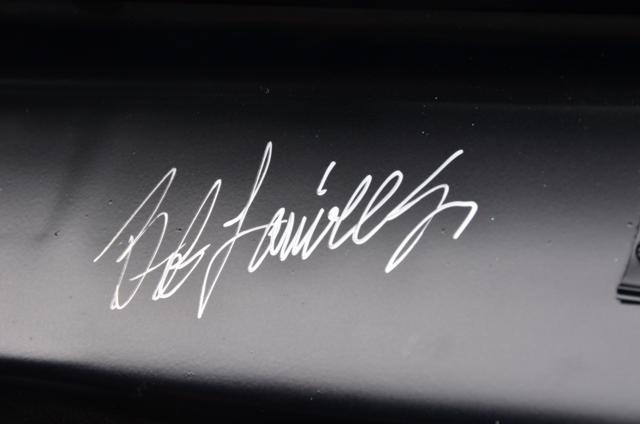
Bob Larivee signed the engine compartment of Julianoâs three Rapid Transit System Caravan carsâafter having Juliano point out which cars they were in his collection (all the others are stock).

